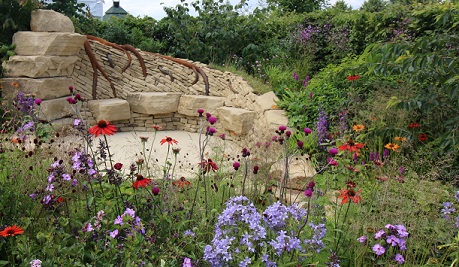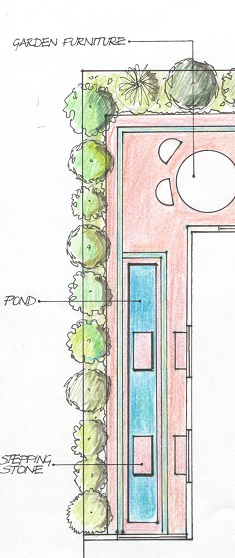Sneak Peek
This is a self Paced 20-hour course to help you understand and Discover the Art and Science of Garden Design.
Designing and building a garden is like creating a living sculpture. The secret to good design is effective planning, coupled with the skills and confidence to put your plans into practice. Although this short course in Designing Gardens is a 20 hour self-paced
course, its coverage is extensive.
Work through the course at your own pace. Do as many or as few of the activities as you need to - this unique format allows you to apply your learning to your own interests and circumstances.
There are seventeen lessons in this course from a basic introduction to
garden design, to following a budget, plant selection, making the garden
meet the house, different designs and using different features to
complete your design. As you progress through each lesson you will be provided with a range of
ways you can expand your learning. By choosing which tasks you do and
don't undertake you can expand in areas that interest you most, and skip
areas of less interest.
At the end of each lesson, you will be given a short self assessment test to
undertake, which will provide an indication of how your learning is
progressing. You can choose to undertake a more formal online assessment at the end of the course, if you wish, to obtain a formal 'Certificate of Completion'.
Our 20 hour courses are self paced and will help you understand a topic in a short amount of time.

COURSE CONTENT - What do you learn?
LESSON 1: INTRODUCTION TO GARDEN DESIGN
- DO IT IN STAGES
- THE PLANNING PROCESS
- EARTHWORKS
- DESIGN IS A PROCESS
- HOW TO DESIGN A GARDEN ROOM STEP-BY-STEP
- GARDEN ROOM COMPONENTS - WHAT TO PUT IN YOUR GARDEN ROOM
- DESIGNING A GARDEN FOR A NEW HOUSE
LESSON 2: APPROPRIATENESS OF GARDEN DESIGN
- TECHNIQUES FOR KEEPING IN SCALE
- THE IMPORTANCE OF SPACE
- GARDEN FEATURES FOR SMALL GARDENS
LESSON 3: CREATING AN IMPACT
- BORROW YOUR NEIGHBOURS LANDSCAPE TO MAKE YOUR GARDEN SEEM LARGER
- BRINGING THE OUTSIDE IN
- BRINGING THE GARDEN INSIDE
LESSON 4: DESIGNING TO A BUDGET
- WORKING OUT YOUR BUDGET
- MAINTENANCE COSTS
- THE PLANT BUDGET
- SELECTING AND MAINTAINING YOUR TOOLS
LESSON 5 CHOOSING PLANTS
- WHAT VARIETY?
- WHICH PLANT?
LESSON 6: USING THE GARDEN
- OUTDOOR LIVING
- GARDEN FURNITURE
- BARBEQUES
- CHILDREN PLAYING
- MAKE GARDENS MORE USER FRIENDLY
LESSON 7: WHERE THE GARDEN MEETS THE HOUSE
- WHAT TO DO
- PRACTICAL CONCERNS
- OTHER WAYS OF JOINING THE GARDEN AND HOUSE
LESSON 8: MAKING THE WINTER GARDEN MORE COMFORTABLE
- SOLUTIONS FOR SLIPPERY SURFACES
LESSON 9: GARDENS FOR CHILDREN
- PLAY EQUIPMENT FOR DIFFERENT AGES
- CHILDPROOFING A GARDEN
- PLAY EQUIPMENT
LESSON 10: THE SECURE HOME AND GARDEN
LESSON 11: LIGHTING A GARDEN
LESSON 12: DEALING WITH SHADE
- TREES TO CREATE SHADE
- ENTERTAINING IN A SHADED GARDEN
LESSON 13: GARDEN ART
- CHOOSING GARDEN ORNAMENTATION
- GARDEN SCULPTURE
- OTHER ORNAMENTATION
LESSON 14: POTS & PLANTERS
- LOOKING FOR COLOURFUL POTS
- USING COLOURFUL POTS
LESSON 15: COLOUR IN THE GARDEN
- COLOURS AND GARDEN STYLES
- TIPS FOR USING COLOUR
- SEASONAL COLOUR
- TIPS FOR YEAR-ROUND COLOUR
- HOW TO BRIGHTEN A WINTER GARDEN
LESSON 16: APPLICATIONS FOR COLOUR
- TEN WAYS TO USE COLOUR
- COLOUR THEMES
LESSON 17: GARDEN FURNITURE
- FURNISHING THE GARDEN
- WHAT FURNITURE DOES YOUR GARDEN NEED?
- WHERE TO PUT YOUR GARDEN FURNITURE
- WHAT TO LOOK FOR IN GARDEN FURNITURE
- BARBEQUES
- WASHING LINES
- HAMMOCKS
- UMBRELLAS
- POOL SIDE FURNITURE
- COLOURS
A PLANNED GARDEN ALWAYS PRODUCES BETTER VALUE FOR YOUR INVESTMENT
 Learn how garden planning not only produces a better garden; but can also save on cost. A little planning can save you much time and money.
Learn how garden planning not only produces a better garden; but can also save on cost. A little planning can save you much time and money.
Plan a Long-Term Budget
The eventual cost of an average home garden can work out to be very expensive over a long period of time. However, you often don’t notice the cost because the money is spent in a haphazard way. If you plan a budget from the beginning, you can prioritise your spending and perhaps even reduce your overall cost.
Mistakes to Avoid
With no overall plan or concept, many new home owners set about simply making their property presentable within a limited budget. Here are some common mistakes you should try to avoid:
- Laying down lawn over most of the property -later you may realise some lawn areas are in the wrong place and need to be pulled up (which costs money) and replaced with something else (which costs more money).
- Not cleaning out the building rubbish before starting - it may be tempting to hide discarded bricks, small pieces of metal or other building debris under a layer of top soil, but this rarely works. They will very likely impede plant growth, and when you dig the soil later on you may damage your tools or hurt yourself on sharp half-buried objects.
- Inadequate preparation of gardens and lawns -all too often, new plantings fail to thrive because te plants are growing in poor quality soil. As a result, a lot of money is spent on fertiliser and replanting. Eventually you may end up buying new soil and repairing the whole area.
- Planting the wrong types of plants for your garden - always ask your local nursery for advice on suitable plants. Be especially careful when choosing and planting trees – large trees in small gardens planted too close together or too close to buildings, power lines, etc are not only potentially dangerous, they can be expensive and difficult to remove. Before you plant, find out how large the tree is likely to grow in your area.
Other Considerations
You probably can’t have everything you want, so will you need to decide what your priorities are:
- A functional garden - i.e. a garden that is used a lot, perhaps for outdoor play for kids, for growing vegetables and fruit, or for entertaining.
- A very attractive garden – this is likely to cost more to set up and maintain, and will almost certainly require a high degree of maintenance.
- A low maintenance garden – this needs a lot of forethought, do it right and you’ll reap the benefits for years to come.
- A low cost garden – bargain plants can often be found at weekend markets and discounted stock at nurseries. Inexpensive landscaping materials can be found at demolition yards, tip shops, and in the classifieds of your local paper.
What type of garden is most important to you? To achieve any one of these things will usually mean compromising the others.
COURSE FEATURES
This short course is an ideal learning experience for anyone seeking to improve their understanding of landscaping.
- 20-hour, self-paced course
- Fully online
- Optional, very practical set tasks throughout
- Automated self assessment tests
- Certificate of Completion on achieving a 60% pass rate on a final assessment
How does this course work?
You can enrol at any time. Once you have paid for the course, you will be able to start straight away. Study when and where you like. Work through at your own pace.
You can download your study-guide to your smart phone, tablet or laptop to read offline.
There are automated self-assessment tests you can complete at the end of each lesson. You can attempt these as many times as you wish and each time, upon completion, you can see your results. You will need internet access to complete the self assessment tests.
At the end of the course, you are presented with a large assessment which can be attempted online, anywhere, anytime. If you achieve a 60% pass in the exam; you immediately receive a downloadable certificate of completion with your name on it. If you do not achieve a 60% pass rate, you can contact us to re-sit your exam. ( email- admin@acs.edu.au )
Contact us at anytime if you have any issues with the course. admin@acs.edu.au